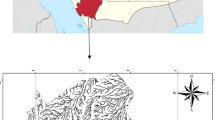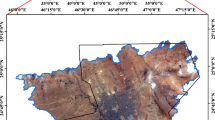Abstract
The curve number (CN) is a hydrologic parameter used to describe the stormwater runoff potential for drainage areas, and it is a function of land use, soil type, and soil moisture. This study was conducted to estimate the potential runoff coefficient (PRC) using geographic information system (GIS) based on the area’s hydrologic soil group, land use, and slope and to determine the runoff volume. The soil map for the study area was developed using GPS data carried on to identify the soil texture to be used in building a soil hydrological groups map. Unsupervised and supervised classifications were done to Landsat 5/7 TM/ETM image to generate land-use and land-cover map. This map was reclassified into four main classes (forest, grass and shrub, cropland, and bare soil). Slope map for Al-Baha was generated from a 30-m digital elevation model. The GIS technique was used to combine the previous three maps into one map to generate PRC map. Annual runoff depth is derived based on the annual rainfall surplus and runoff coefficient per pixel using raster calculator tool in ArcGIS. An indication that in the absence of reliable ground measurements of rainfall product, it can satisfactorily be applied to estimate the spatial rainfall distribution based on values of R and R 2 (0.9998) obtained. Annual runoff generation from the study area ranged from 0 to 82 % of the total rainfall. Rainfall distribution in the study area shows the wise use of identifying suitable sites for rainwater harvesting, where most of the constructed dams are located in the higher rainfall areas.




















Similar content being viewed by others
References
American Society of Civil Engineers (ASCE) (1992) Design and construction of urban stormwater management systems. American Society of Civil Engineers, New York
Browne FX (1990) Stormwater management. In: Corbitt RA (ed) Standard handbook of environmental engineering. McGraw-Hill Inc, New York, pp 7.1–7.135
Cheng Q, Ko C, Yuan Y, Ge Y, Zhang S (2006) GIS modeling for predicting river runoff volume in ungauged drainages in the Greater Toronto Area, Canada. Comput Geosci 32(8):1108–1119
Chow VT, Maidment DR, Larry W, Mays NO (1988) Applied hydrology. McGrawHill International, New York
De Winnaar G, Jewitt GPW, Horan M (2007) A GIS-based approach for identifying potential runoff harvesting sites in the Thukela River basin, South Africa. Phys Chem Earth Parts A/B/C 32(15):1058–1067
Dunne T, Leopold LB (1978) Water in environmental planning. Freeman, San Francisco
El-Hawagry MS, Khalil MW, Sharaf MR, Fadl HH, Aldawood AS (2013) A preliminary study on the insect fauna of Al-Baha Province, Saudi Arabia, with descriptions of two new species. ZooKeys 274:1
Fetter CW Jr (1980) Applied hydrogeology. Charles E. Merrill and Co., Columbus, 484 pp
Hydrology I (1976) Water balance of the headwaters oin catchemnts wye and severen. 1970–1975. Report No. 33. Institute of Hydrology, UK
Kirkby MJ, Beven KJ (1979) A physically based, variable contributing area model of basin hydrology/Un modèle à base physique de zone d’appel variable de l’hydrologie du bassin versant. Hydrol Sci J 24(1):43–69
Law F (1956) The effect of afforestation upon the yield of water catchment areas. Technical report. British Association for Advancement of Science, Sheffield
Liu YB (2004) Development and application of a GIS-based hydrological model for flood prediction and watershed management. PhD Thesis, Vrije Universiteit Brussel, Belgium
Liu YB, De Smedt F (2004) WetSpa extension, a GIS-based hydrologic model for flood prediction and watershed management. Vrije Universiteit Brussel, Belgium, pp 1–108
Liu YB, De Smedt F, Gebremeskel S (2000) Hydrologic modeling on a catchment scale using GIS and remote sensed land use information. Risk Anal II:295–304
Mallants D, and Feyen J (1990) Kwantitatieve en kwalitatieve aspecten van oppervlakte en grondwaterstroming (Quantitative and qualitative aspects of surface and groundwater flow) in Dutch, Volume 2., KUL, Leuven, Belgium.
Mulholland PJ, Wilson GV JP (1990) Hydro geochemical response of a forested watershed to storms effects of preferential flow along shallow and deep pathways. Water Resour Res 26(12)):3021–3036
Ramakrishnan D, Bandyopadhyay A, Kusuma KN (2008) “SCS-CN and GIS based approach for identifying potential water harvesting sites in the Kali Watershed, Mahi River Basin, India”. J Earth Syst Sci 118(No. 4):355–368
Rao KHV, Durga, Bhaumik MK (2003) Spatial expert support system in selecting suitable sites for water harvesting structures -a case study of Song Watershed, Uttaranchal, India. Geocarto Int 18:43–50
Saudi Geological Survey (2012) Facts and numbers (In Arabic)
Schwab G O, Frevert R K (1993) Elementary soil and water engineering. Krieger Publishing Company, Melbourne
Senay GB, Verdin JP (2004) Developing index maps of water-harvest potential in Africa. Appl Eng Agricult 20(6):789–799, 12
Sharma KD (1986) Runoff behaviour of water harvesting microcatchments. Agric Water Manag 11(2):137–144
Sherman L (1932) Stream flow from rainfall by unit hydrograph method. Eng News Rec 108:501–505, Chicago
Sivapalan M, Blöschl G, Merz R, Gutknecht D (2005) Linking flood frequency to long-term water balance: incorporating effects of seasonality. Water Resour Res 41(6):W06012. doi:10.1029/2004WR003439
Texas Department of Transportation (TxDOT) (2002) Hydraulic design manual. TxDOT Hydraulics Branch of the Bridge Division, Austin, 78701
USDA (2004) Estimation of direct runoff from storm rainfall, National Engineering Handbook, pp 79
USDA, Soil Conservation Service, Plant Materials Centers (1988) Plant materials handbook. (For Arizona, Colorado, Montana, New Mexico, North and South Dakota, Utah and Wyoming) US Dept. of the Interior, Office of Surface Mining-Reclamation and Enforcement
Victor MP, Hawkins RH (1996) Runoff curve number: has it reached maturity. J Hydrol Eng 1(1):9
Viglione A, Merz R, Bloschl G (2009) On the role of the runoff coefficient in the mapping of rainfall to flood return periods. Hydrol Earth Syst Sci 13:577–593
Wanielista MP, Yousef YA (1993) Stormwater management. Wiley, New York
Acknowledgments
We gratefully thank the two anonymous reviewers for their thoughtful comments, which substantially improved this manuscript.
This project was financially supported by King Saud University, Deanship of Scientific Research, College of Food and Agricultural Sciences, Research Center.
Author information
Authors and Affiliations
Corresponding author
Rights and permissions
About this article
Cite this article
Mahmoud, S.H., Mohammad, F.S. & Alazba, A.A. Determination of potential runoff coefficient for Al-Baha Region, Saudi Arabia using GIS. Arab J Geosci 7, 2041–2057 (2014). https://doi.org/10.1007/s12517-014-1303-4
Received:
Accepted:
Published:
Issue Date:
DOI: https://doi.org/10.1007/s12517-014-1303-4




